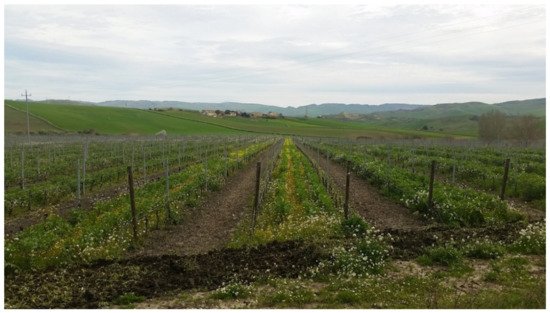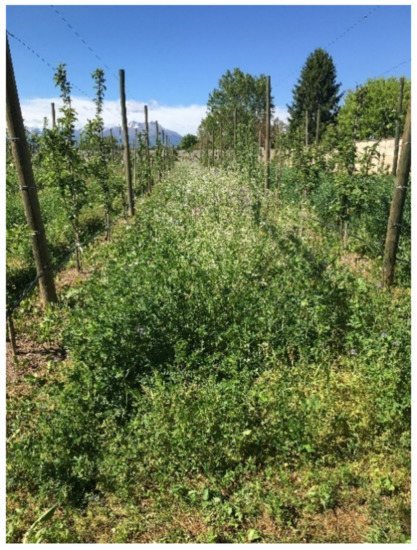Your browser does not fully support modern features. Please upgrade for a smoother experience.
Please note this is a comparison between Version 1 by giovanna giacalone and Version 2 by Amina Yu.
A cover crops is defined as a “close-growing crop that provides soil protection, seeding protection, and soil improvement between periods of normal crop production, or between trees in orchards and vines in vineyards”. This definition indicates a number of benefits deriving from the application of soil management models which have, however, found discontinuous application in orchards due to different interpretations of the direct effects on production and fruit quality. Soil management is, in fact, one of the key practices that influences the vegetative and productive activity of an orchard.
- cover crops
- fruit orchards
- quality
- sustainability
- ecosystem services
1. Fruit Quality in Relation to Cover Crops
Competition for water and nutrients considerably influences the development of the plant, its maturity, fruit ripening, yields, and quality, mostly due to different behavior in terms of the tree vigor [1][2][33,34]. Many positive effects have been evidenced, in terms of fruit skin color distribution, sugar accumulation [3][35], and flowering induction [4][36]. The reduction in vigor, moreover, allows trees to obtain a more compact canopy with reduced competition between vegetative organs and fruits for the translocation of nutrients from the roots to the aerial part [2][34]. The effect of the competition exerted by cover crops is not always positive. Several authors, in fact, have shown that partial or total cover determines a reduction in production on pear, apple, and peach trees compared to tilling or weeding, with a corresponding positive effect on fruit size [5][6][7][8][9][10][11][12][19,37,38,39,40,41,42,43]. A negative effect of cover crops on yield has been observed on grapevines [13][44], although a comparison between soil under conventional management and artificially grassed soil showed no significant differences regarding quantity and quality of production, as well as in case of water shortage, where a reduction in plant vigor, but not in production quantity, was registered [14][45]. The same behavior appeared in peaches and apples [15][46] when comparing different soil management approaches.
As regards fruit quality, soluble sugars, titratable acidity, and pulp firmness at ripening, as well as the total phenolic contents, have been studied and showed results which were not always unambiguous. Gormeley et al. [16][47] on Cox’s Orange Pippin and Red Jonathan apples from orchards with different soil management techniques (grassed, mechanically tilled, and weeded), found lower yields on grassed plots for both cultivars, and grassing improved the Cox’s Orange Pippin apple quality only marginally, even in more recent experiments [17][48]. From a gustative perspective, panels did not show a clear preference for fruits of a specific treatment, probably because the sugar contents of apples from the different soil management conditions were comparable anyhow. Different results were revealed in Golden Delicious apples, with higher quality and better panel in fruits from the grassed plots [18][19][49,50]. Appropriately managed sub-row grassing positively affected some quality parameters also in peaches, such as flesh texture, soluble solids content (SSC), and dry matter content [20], evidencing the opportunity to associate biodiversity while avoiding any negative effects on either tree growth or fruit yield and quality.
Different management methods were also applied on blackberries [21][51], where manual weeding, total grassing (non-weeded), and mulching with a weed mat were compared. Weed management had no effect on the pH, titratable acidity, and soluble solids content of the fruit, while it was found to have a significant effect on total phenols, monomeric anthocyanins, ORAC, FRAP, sugar profile, and aromatic intensity. In particular, weeding in the row resulted in a higher content of antioxidants with higher antioxidant capacity in early harvests while, in late harvests, the fruits of totally grassed areas provided the highest values. Mulching with a weed mat always gave the worst values for all parameters considered [21][51].
In vineyards, the effect of cover crops has been widely studied in relation to the quality of the product at harvest (Figure 13). The competition was shown to positively affect grape and must quality, increase soluble solids, anthocyanin content, and phenolic components and decrease titratable acidity and pH [22][52]. These results were confirmed for Sangiovese vines, for which a higher polyphenol content was measured in wines produced from grapes obtained from grassed rows compared to those produced from grapes obtained from tilled rows [23][24][53,54]. In general, cover crops reduce the nitrogen levels in grape juice by up to 16% compared to those from a conventionally tilled vineyard [25][55]. In some cases, particularly for white grape varieties, this reduction could determine a detriment of digestion by yeasts [26][56] with a possible alteration of fermentation and many negative effects on the aromatic complex [27][57].

Figure 13. Vineyard with cover crops in alternate rows in Sicily. A mixture of different weeds is frequently used.
More recently, the attention of research has been focused on the effect of seed mixture and the duration of grassing on fruit quality. A study on pear trees has shown that, after a long period, spontaneous grassing can bring advantages in fruit texture, soluble solids, total aroma, and acid–sugar ratio. In fact, all these parameters were better in pears derived from orchards naturally grassed for 4 to 7 years than in orchards grassed for only 2 years [28][58]. Different types of soil cover (herb lay, ryegrass, red clover, and compost), on the other hand, determined changes in the quantity and quality of yields in Braeburn and Royal Gala apple orchards. Specifically, there was a significant increase in yield when cover crops were realized with red clover compared to herb lay or ryegrass. Clover also favored a greater accumulation of N in the fruits, thus modifying the vegetative–productive balance and determining a delay in harvesting. The sugar content was lower in red clover than in other treatments, while all types of grasses were found to be better than compost in terms of calcium levels in the fruits [29][59]. These results have been confirmed by several studies on apples, especially when the vegetation cover is made with legumes, with a natural increase in the soil nitrogen content available to the plant [30][60] also determining lower soluble solids content and lower pulp firmness [29][31][59,61]. Wheeler and Pickering [32][62] reported a marked reduction in juice ammonia levels in grapes grown with chicory (Chichorium intybus) competition compared to bare or tilled soil. Muscas et al. [33][63] showed different effects on must quality in plots artificially grassed with a mixture of grasses, where musts had a higher content of sugars, anthocyanins, and polyphenols; in plots grassed with a mixture of legumes and in those with natural grassing, a reduction in total polyphenols and anthocyanins, respectively, was observed [34][64].
Postharvest fruit performance, as related to soil management, is another aspect that has been investigated, evidencing an undoubted influence on shelf life and quality maintenance post-harvest. Wallace [35][65], reporting the results of a decade of observations, showed that apples derived from grass orchards have a lower N content than fruits obtained from clean soils, ripen more slowly, and are less prone to physiology disorders during storage and rot. High levels of N, indeed, are correlated with a higher occurrence of Gloeosporium rot (mainly by G. album), which is, instead, reduced in fruits derived from green orchards [36][37][66,67]. The higher potassium content, again due to the turf, also reduced product losses due to low temperature breakdown. In a study of Cox and Spartan apples, Perring and Pearson [38][68] showed that the calcium content in the core of fruits obtained from grassed and irrigated plots was higher than that in fruits from totally weeded plots with a better redistribution of calcium to other tissues during cold storage at 0 °C. The same study found that, in apples prone to calcium deficiency disorders, such as Braeburn, the calcium levels were positively affected by cover crops [39][69].
2. Ecosystem Services Affected by Cover Crops
In 1997, Tilman et al. [40][4] demonstrated an increase in ecosystem services in complex systems due to increased resource use efficiency. This theory started from the observation of natural systems but has recently landed in the discussion of the sustainability of agroecosystems [41][70] and the opportunity that adequately designed cover crops have to provide ecosystem services. Although much of the research on cover crops predates the introduction of the concept of “ecosystem services” [42][8], it is possible to identify as many as 19 ecosystem services in the use of cover crops in perennial woody systems (such as fruit and viticulture). Of these, ten can be defined as regulatory services (beneficial insect conservation, biodiversity support, greenhouse gas (GHG) regulation, nitrate (NO3) leaching control, pest suppression, pollination support, soil retention improvement, water dynamics regulation, weed suppression, and wildlife habitat provision), seven as support services (arbuscular mycorrhizal fungi, colonization, biomass production, regulation of water dynamics, nitrogen mineralization, nutrient cycling, soil carbon, and soil structure), and three as delivery services (crop yield, economic viability, and knowledge dissemination). Perennial agroecosystems present high variety in terms of species, climate, soil, agronomic techniques adopted, and the duration of planting, as well as, especially for soil management, in terms of plant co-openings with different mixtures.
Indeed, the combination of a plant cover in the inter-rows of orchards and vineyards with the application of external organic amendments (e.g., compost) or crop residues (e.g., pruning debris) would be a suitable management strategy (Figure 24).

Figure 24. Inter-row green meanure in apple orchard in Piedmont.
Data from the literature [43][73] reported that cover crops are able to increase soil organic C stocks, and the sequestration rate appears highest during the first years and progressively decreases as the C stocks approach an equilibrium. In the same way, cover crop research has long focused on integrated pest management (IPM) [44][74], considering cover crops as a key element in defense strategies to create refuge areas for beneficial insects, as well as hedges and flower strips [45][75]. In general, the combination of perennial crops and cover crops improves the biotic interactions responsible for pest control through biological control and, more generally, for pollination, which is seen as an ecosystem service for the resilience of rural environments. In other cases, by introducing this new biodiversity, it is possible to start a new ecological process through planting together plants that emit naturally repellent chemicals [46][76]; Centaurea cyanus, Satureja hortensis, and Ageratum houstonianum in pear orchards can reduce the number of plant-damaging herbivorous pests and increase the abundance of predators and parasitoids [47][77]. In addition, the positive effects of cover and hedgerow species richness on pollination rates have been demonstrated in fruit orchards [48][49][78,79]. Most pollinator species depend on different floral resources [48][78], also demonstrating the close relationship between flowering plants within and adjacent to apple trees and flower visitation rates by pollinating insects [50][80].
Buffer strips, together with cover crops, have the potential to maintain wildlife species (e.g., nectar feeders, pollinators, birds, and mammals). The diversity and richness of vegetation in buffer areas (such as grass strips or field margins) can positively modify the plant biodiversity within the cultivated area in intensively cultivated agroecosystems, thus enhancing the ecosystem services [51][52][81,82].
